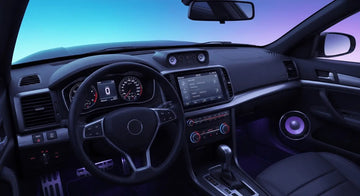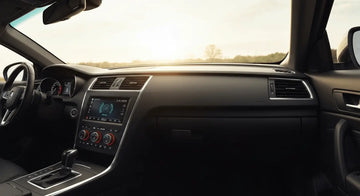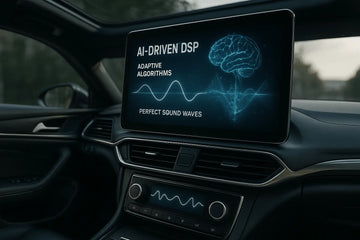When upgrading your car's sound system, one of the key components that can make a huge difference in audio quality is the digital signal processor (DSP). The automotive sound market offers a wide range of DSP options, each with its unique features and capabilities. In this blog, we will explore the world of car audio DSPs, understanding their importance, types, key features like input signal adjustment, output parametric equalizer options, and factors to consider when choosing the right one for your vehicle.
Understanding Car Audio DSP

Before diving into the specifics of car audio DSPs, it is essential to have a basic understanding of what they are and how they work. A digital signal processor, or DSP, is an electronic device that processes audio signals in a car's sound system. It allows for adjustments like high accuracy equalization and fine-tuning of the sound, enhancing the overall audio experience in the vehicle. Whether you're a casual music lover or an audio enthusiast who prefers genres like hip hop, a car audio DSP can significantly improve the sound quality of your car's audio system.
What is a Car Audio DSP?
A car audio digital sound processor, or DSP, is a device that enhances the audio source in a car's sound system. It provides professional equalization adjustments with specific frequency settings and variable equalizer bandwidth, allowing for precise sound tuning. DSPs feature an integrated audio generator, which enables accurate measurements and sound treatment functions. They also offer intuitive interfaces, often using PC software, making management functions easy to control. With input parametric equalizers, cut frequencies, and attenuation rates, car audio DSPs provide seamless audio adjustments to the sound system, resulting in an enhanced user experience.
Importance of a Car Audio DSP in Your Vehicle

The importance of a car audio DSP in your vehicle cannot be overstated. It is crucial in achieving optimal sound quality with features like signal change processing and enhancing the overall user experience. By offering professional equalization adjustments, a car audio DSP allows for precise control over the sound system, ensuring that the audio output is tailored to your preferences. Whether you enjoy powerful bass, crystal-clear vocals, or detailed high frequencies, a DSP can fine-tune the audio with specific frequency setting, cut frequencies, and attenuation rates to meet your needs. Audio adjustments such as bass boost, treble adjustments, and equalizer settings can all be easily controlled through a car audio DSP, giving you the ability to customize the sound to perfection.
Types of Car Audio DSPs

Several types of car audio digital signal processors (DSPs) are available in the market, each with its own features and advantages. The three main car audio DSPs are standalone, built-in DSPs in head units and amplifiers. Understanding the differences between these types can help you make an informed decision when choosing the right DSP for your car audio system.
Standalone DSPs
Standalone car audio DSPs are independent units installed separately from other components. They offer greater control and flexibility, allowing for customization of the sound system. Standalone DSPs feature multiple input and output channels, enabling connecting various audio sources and speakers. These DSPs act as sound processors, processing the audio signals and adjusting the sound output according to the user's preferences. Standalone DSPs often come with software that allows for manual tuning of the input and output channels, making achieving the desired audio adjustments easier.
Built-in DSPs in Head Units
Many modern car audio head units have built-in digital signal processors (DSPs). These integrated DSPs offer the convenience of having the processing capabilities directly within the head unit, eliminating the need for a separate standalone processor. Built-in DSPs often feature an integrated audio generator, allowing accurate measurements and sound treatment functions. They also come with user-friendly interfaces, making controlling and adjusting the audio settings easy. Built-in DSPs are famous for car audio enthusiasts looking for a streamlined audio system without additional components.
DSPs in Amplifiers
Another option for incorporating digital signal processing into your car audio system is using DSPs in amplifiers. These DSPs are integrated into the amplifier, offering the advantage of combining the processing power and amplification capabilities in a single unit. DSPs in amplifiers feature independent outputs, allowing for precise audio adjustments and control. They often include crossover functions, enabling audio signal splitting into specific frequency ranges. DSPs in amplifiers are a popular choice for car audio installations that require high-quality audio processing and amplification in a compact package.
Key Features of a Good Car Audio DSP

When choosing a car audio DSP, several key features must be considered. These features can significantly impact your car audio system's sound quality and overall performance. Some essential features of a good car audio DSP include equalization capabilities, time alignment features, and crossover functions. Let's take a closer look at each of these features and their importance in achieving the best audio experience in your vehicle.
Equalization Capabilities
Equalization is a crucial aspect of sound tuning in car audio systems. A car audio digital sound processor with robust equalization capabilities can significantly enhance the audio output, allowing for detailed adjustments to the frequency response. Some important equalization capabilities to consider when choosing a car audio DSP include:
- Parametric equalization Allows precise control over specific frequency bands, fine-tuning the sound to your preferences.
- Band equalizer: Provides control over different frequency ranges, allowing for adjustments of bass, midrange, and treble frequencies.
- Treble boost: Enhances high-frequency reproduction, adding clarity and sparkle to the audio.
- Bass boost: Increases low-frequency response, adding depth and impact to the audio.
- Graphic equalizer: Offers graphical control over the frequency spectrum, allowing for broader adjustments across the audio range.
Time Alignment Features
In a car audio system, time alignment refers to the fine-tuning of speaker placement and signal delay, ensuring that sound from each speaker arrives simultaneously at the listener's ears. This feature is essential for creating an accurate soundstage, where the audio appears from specific car locations. A car audio DSP with time alignment features allows for precise adjustments, optimizing the sound imaging and creating a more immersive audio experience. Accurate measurements, such as speaker distance and signal delay, are used to fine-tune the time alignment settings, ensuring the best possible sound reproduction in the car.
Crossover Functions
Crossover functions play a vital role in car audio systems by splitting audio signals into specific frequency ranges, ensuring each speaker receives the appropriate frequencies. This feature allows for better sound reproduction, reducing distortion and improving overall audio quality. A car audio DSP with crossover functions offers precise control over the crossover points and slope of the filters, allowing for fine adjustments to match the characteristics of the speakers. Some key elements of crossover functions to consider when choosing a car audio DSP include:
- Highpass filters: Allow frequencies above a certain point to pass through, ensuring the bass frequencies are sent to the subwoofer. In contrast, the midrange and treble frequencies are directed to the corresponding speakers.
- Lowpass topology: Filters out frequencies above a specific cut-off point, preventing bass frequencies from being sent to the small speakers, resulting in clearer audio reproduction.
- Crossover function: Controls the transition between the highpass and lowpass filters, ensuring a seamless frequency response across the audio spectrum.
User Interface and Software
A car audio DSP's user interface and software play a crucial role in the device's ease of use and customization options. A user-friendly interface with intuitive controls allows for easy access to audio adjustments, making it easier to fine-tune the sound system according to your preferences. Look for car audio DSPs with easy-to-navigate interfaces, clear LCD displays, and intuitive software.
This will enable you to make accurate adjustments, whether you prefer manual tuning or prefer to load settings from pre-configured profiles. Good software will also provide functions of management, language selection, text display, and, in some cases, remote control options, enhancing the overall user experience.
How to Choose the Right DSP for You?

Choosing the right car audio DSP can be challenging, considering the plethora of options available in the market. To ensure you make the best choice for your specific needs, here are some factors to consider when selecting a car audio DSP:
- Professional equalization adjustments: Look for a car audio DSP that can make professional equalization adjustments, allowing for precise sound tuning and customization.
- Integrated equalization system: Opt for a DSP with an integrated equalization system, providing seamless audio adjustments and fine-tuning capabilities.
- Integrated audio generator: Consider a car audio DSP with an integrated audio generator, enabling accurate measurements and professional audio treatment functions.
- Detailed equalization control: Look for a DSP that provides detailed equalization control, offering band equalizer settings, treble boost, bass boost, and parametric equalization options.
- Phase inversion: Consider a car audio DSP incorporating phase inversion capabilities, allowing for audio treatment functions and precise sound adjustments.
What Factors Should You Consider When Buying a Car Audio DSP?
When buying a car audio DSP, several factors should be considered to ensure you choose the right one for your audio needs. Some of the key factors to consider include:
- Input channels: Determine the number of input channels required to connect your audio sources, such as head units, media players, or smartphones.
- Output channels: Consider the output channels needed to connect your speakers, subwoofers, or amplifiers, ensuring compatibility with your audio setup.
- Equalization control: Look for a car audio DSP that provides detailed equalization control, allowing for fine adjustments of frequencies and sound characteristics.
- User interface: Consider the user interface of the car audio DSP, including the ease of navigation, intuitive controls, and visual display, to ensure a seamless user experience.
- Remote control options: The availability of remote control options, such as remote trigger connection or remote input, can enhance the convenience of remotely managing and adjusting the audio settings.
In addition to these factors, other considerations such as security password, credit card, and free shipping may play a role in your purchase decision, depending on your preferences and budget.
Frequently Asked Questions

Can a car audio DSP be installed in any type of vehicle?
Yes, car audio DSPs can generally be installed in any vehicle. However, the installation process may vary depending on the make and model of the vehicle. It is recommended to consult with a professional installer to ensure the proper installation of the car audio DSP in your specific vehicle. Some car audio DSPs may require additional accessories or components for optimal performance, so it's essential to consider the specific requirements of your car audio system during the installation process.
What is a car audio DSP, and what does it do?
A car audio DSP, or Digital Signal Processor, is a device that processes audio signals in a vehicle's audio system. It allows for adjustments to the sound, improving overall audio quality through equalization and time alignment. A DSP can also compensate for the acoustics of the car's interior. Popular brands include JL Audio, Audison, and Helix.
What are the differences between analog and digital signal processing in car audio?
The main difference between analog and digital signal processing in car audio is how the audio signal is manipulated. Analog signal processing uses physical hardware components to alter the audio signal, while digital signal processing relies on software algorithms to process the audio signal digitally. Digital signal processing offers more precise control and flexibility than analog processing, improving sound quality. However, some audio enthusiasts prefer the warmer sound of analog processing, which they believe adds a unique character to the audio output.
What are some features to look for when choosing a car audio DSP?
When choosing a car audio DSP, consider features like multiple input and output channels for flexibility, adjustable crossover points for optimal sound quality, time alignment capabilities for improved soundstage, and a user-friendly interface for easy configuration.
Conclusion

In conclusion, choosing the right car audio DSP is essential to enhance your in-car audio experience. Whether you opt for a standalone DSP, a built-in DSP in your head unit, or a DSP integrated into your amplifier, there are key features to consider. Look for a DSP with equalization capabilities, time alignment features, crossover functions, and user-friendly software.
It's also important to consider factors such as compatibility with your vehicle and budget. Investing in a high-quality car audio DSP allows you to enjoy optimal sound quality, improved clarity, and a customized audio setup that suits your preferences. So, take the time to research and choose the right DSP for you and elevate your driving experience to a new level.





